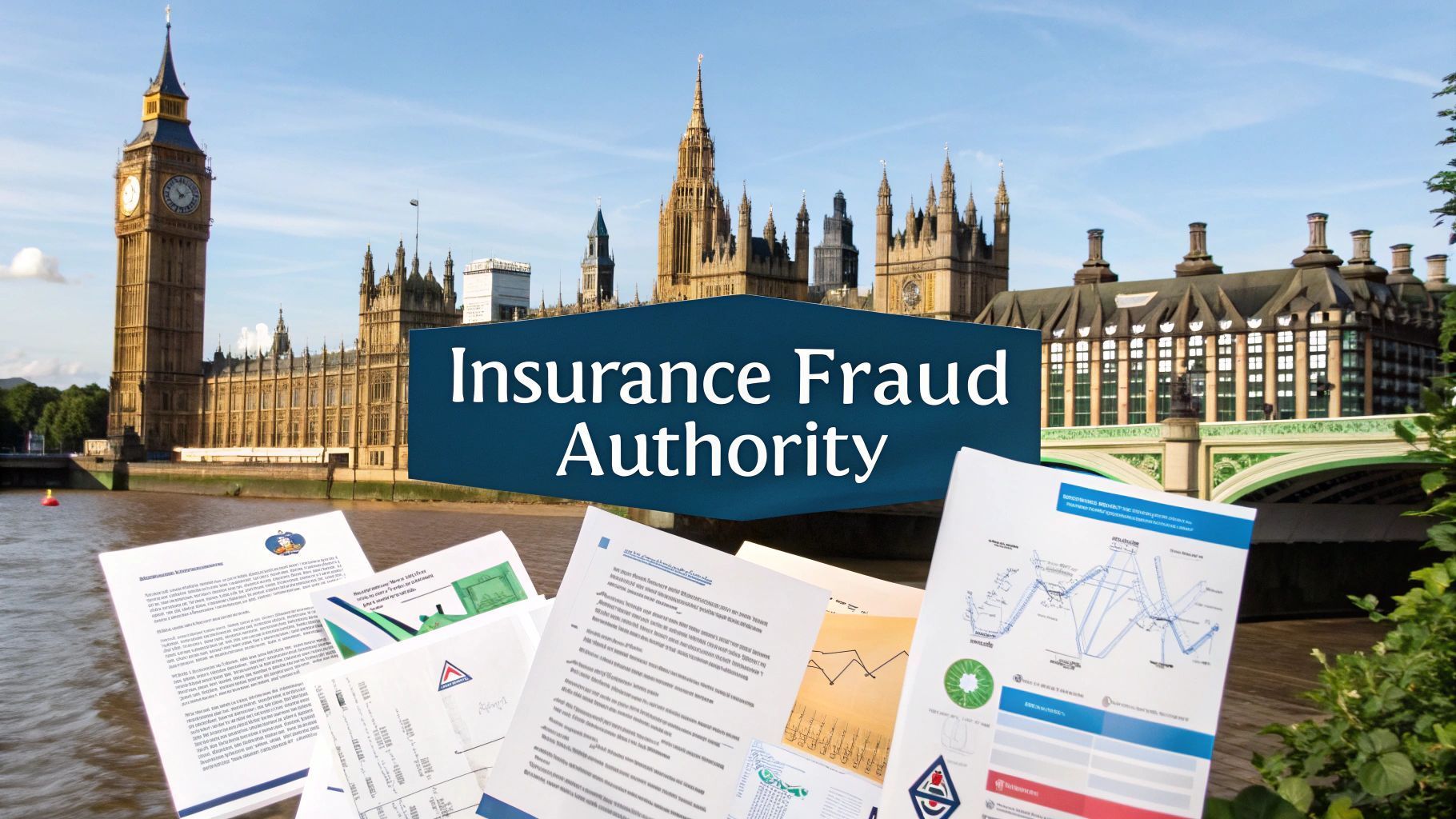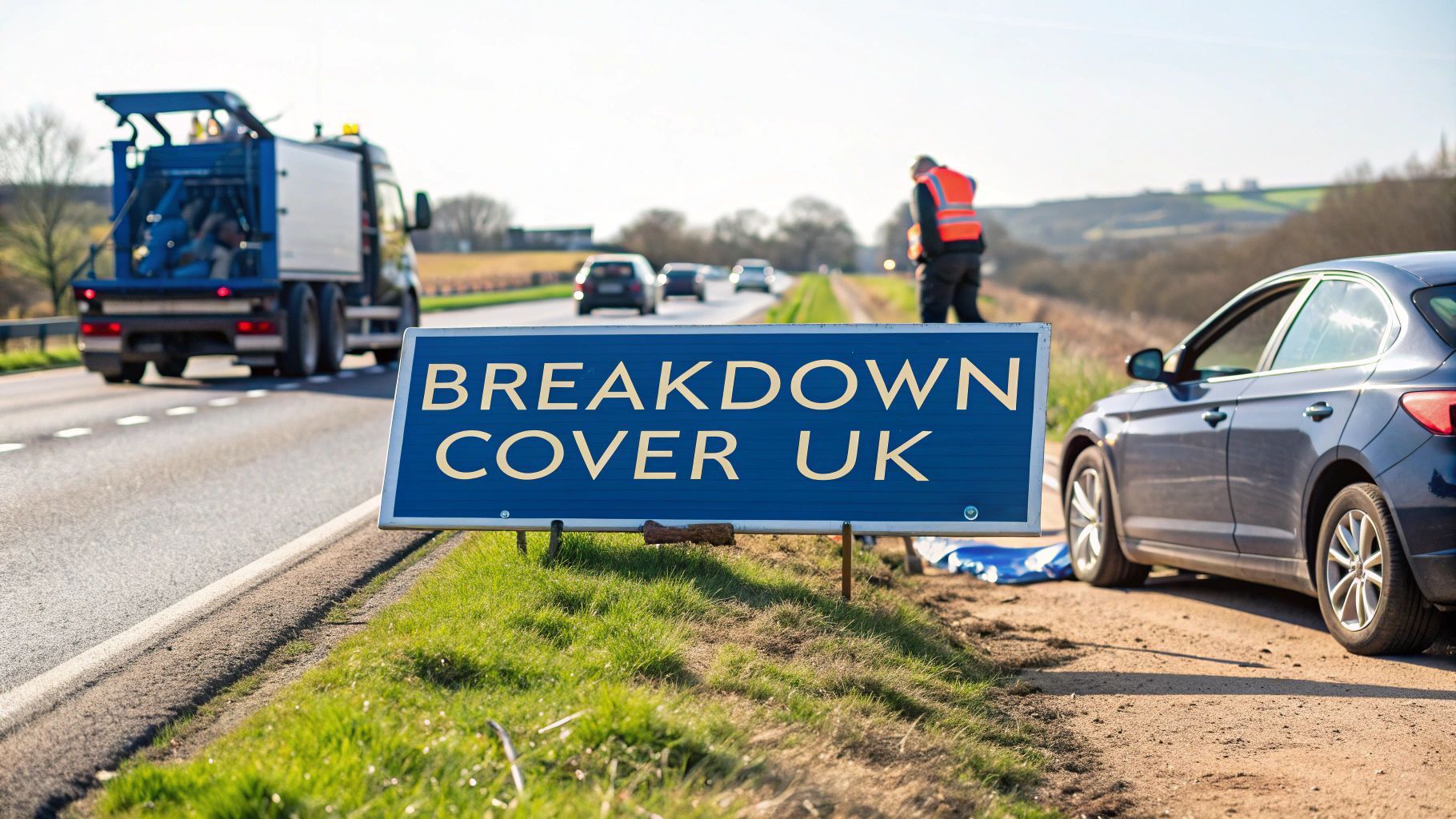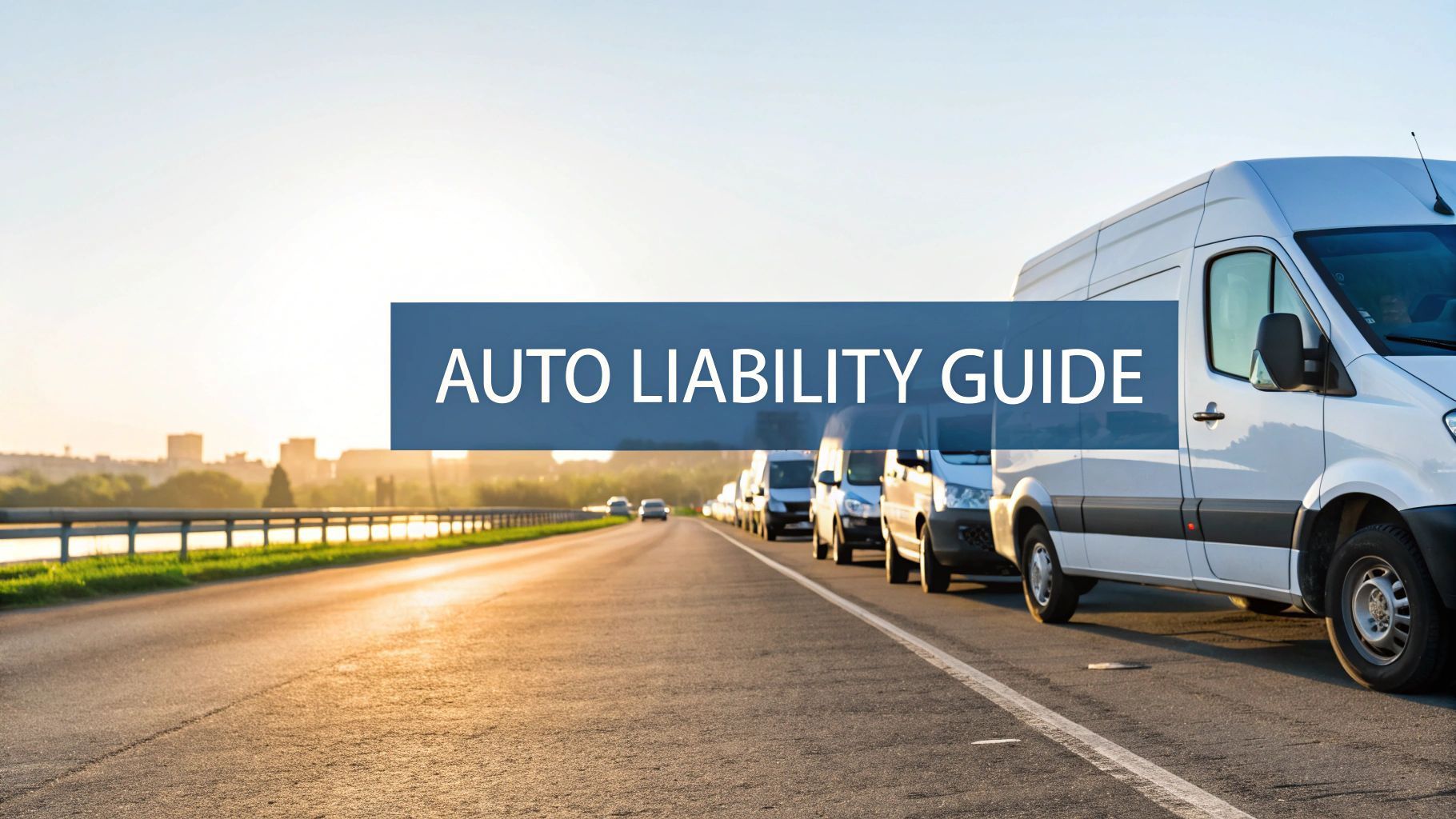A Guide to UK Insurance Umbrella Policies
Think of your standard home or motor insurance as a good, sturdy raincoat. It keeps you dry in a typical downpour. But what happens in a once-in-a-decade superstorm—a catastrophic event like a multi-million-pound liability claim? That’s where you need something more and this is exactly what an insurance umbrella policy is for.
What Exactly Is an Insurance Umbrella Policy?
This isn’t a policy you buy on its own. Instead, it sits over your existing home or motor insurance, acting as a massive extra layer of liability cover. It’s designed for those worst-case scenarios where the financial fallout is simply too big for your standard policies to handle.
If a serious accident happens and you’re found legally responsible for damages that go beyond your primary policy's limit, the umbrella policy steps in to cover the rest.
A Financial Safety Net for When Things Go Seriously Wrong
Let’s put that into a real-world context. Imagine you’re held liable for a major multi-vehicle pile-up. The court hands down a judgement of £1 million but your motor insurance only covers you for up to £500,000 .
Without an umbrella policy, you’d be on the hook for the remaining £500,000 . That’s the kind of debt that forces people to sell their homes, drain their life savings and even have their future wages garnished for years. It's life-altering.
With an umbrella policy, however, that financial disaster is completely avoided. Once your motor policy pays out its maximum, your umbrella cover kicks in to handle the rest, protecting your assets and your future.
The Problem of Proof and Fraud
A huge challenge for insurers, especially with high-value claims that trigger umbrella cover, is proving that everything is legitimate. Insurers have to rigorously verify every detail to protect the system from fraud—which is far from a victimless crime.
When fraudulent claims are paid out, the costs do not just disappear. Insurers are forced to pass them on to every honest policyholder through higher premiums, making essential cover more expensive for everyone.
This creates a critical balancing act for the industry:
- The Burden of Proof: To get a large claim paid, the details must be verifiable and stand up to scrutiny.
- The Cost to Consumers: When fraud succeeds, it inflates the entire cost pool, driving up prices for you and me.
- The Industry Impact: The entire insurance sector has to invest heavily in fraud detection and those costs are ultimately passed on to the customer.
At the end of the day, an umbrella policy is a crucial tool for managing serious personal risk. Understanding how it works—and the challenges like fraud and claim verification that surround it—helps you see its true value. It provides genuine peace of mind, ensuring one terrible event does not lead to total financial ruin.
What an Umbrella Policy Actually Covers
Think of an umbrella policy as a financial safety net but for major, unexpected life events. It’s not a replacement for your standard home or motor insurance; instead, it provides a crucial second layer of liability protection that only kicks in after your primary policy limits have been completely used up.
Its real purpose is to shield you from those rare but catastrophic situations where legal and medical costs spiral into amounts that would otherwise be life-altering.
The power of this cover lies in its sheer breadth. It extends your liability protection across a range of scenarios. For instance, imagine you are found at fault in a serious car accident that causes severe injuries to several people. The combined medical bills and legal judgements could easily blow past the limit on a standard motor policy. That’s precisely when an umbrella policy steps in, covering the excess and protecting your savings, home and other assets from being seized.
This infographic helps visualise how an umbrella policy sits on top of your existing cover.

As you can see, it acts as a supplementary shield, designed to protect you after your first line of defence has been breached.
Common Coverage Scenarios
To get a real sense of its value, let’s look at a few concrete situations where an umbrella policy proves its worth:
- Serious Bodily Injury: A guest slips on an icy patch on your driveway and suffers a permanent disability. Their claim for ongoing medical care, lost income and damages could easily run into the millions—far beyond a standard home insurance liability limit.
- Major Property Damage: A bonfire in your garden gets out of control, spreading to your neighbour’s property and causing substantial damage to their house, garden and vehicles.
- Libel and Slander: You post a scathing online review of a local business. The owner sues you for defamation, claiming reputational damage and financial loss.
- Incidents While Abroad: While on holiday, you accidentally cause an incident that injures someone. The resulting legal action is not fully covered by your standard travel insurance.
In every one of these cases, the umbrella policy takes over once the underlying policy limit is exhausted.
To illustrate this, let's compare how standard insurance stacks up against the protection of an umbrella policy in a few hypothetical scenarios.
Standard Policy Limits vs Umbrella Policy Coverage
| Liability Scenario | Typical Standard Policy Limit | Potential Claim Amount | How an Umbrella Policy Responds |
|---|---|---|---|
| Severe multi-car accident | £500,000 | £1,500,000 | Covers the remaining £1,000,000, protecting your personal assets. |
| Guest injury at your home | £300,000 | £800,000 | Pays the £500,000 shortfall after your home policy maxes out. |
| Defamation lawsuit | £0 (often excluded) | £100,000 | Can cover the full legal costs and settlement, as it often includes personal injury cover. |
| Boating accident | £250,000 | £750,000 | Kicks in to cover the additional £500,000 in liability damages. |
This table shows just how quickly liability costs can exceed standard limits, highlighting the critical gap that an umbrella policy is designed to fill.
The core function of an umbrella policy is to cover exceptionally large but infrequent liability claims. It’s an affordable solution for managing high-impact, low-probability risks that could otherwise lead to financial ruin.
What Is Typically Excluded
Just as important is understanding what an umbrella policy does not cover. These policies are strictly for liability—meaning damage or injury you cause to others. Your own personal losses are not included. Insurers are very clear about these exclusions to manage risk and prevent the system from being misused.
Common exclusions usually include:
- Your Own Injuries: It will not cover your personal medical bills if you get hurt in an accident you caused. That is a job for health insurance.
- Damage to Your Own Property: If you damage your own car or home, you will need to claim on your primary motor or home policies.
- Criminal or Intentional Acts: Insurance is for accidents. Any deliberate action that causes harm to another person or their property is never covered.
- Business-Related Liabilities: A personal umbrella policy will not cover claims related to your professional work or business. For that, you would need a separate commercial umbrella policy.
These exclusions are vital for insurers to prevent fraudulent claims, which ultimately drive up costs for all policyholders. The UK insurance market has seen intense competition recently, with overall rates falling by 6% in Q1 2025. Yet, casualty insurance—which covers the exact liability risks an umbrella policy supplements—actually increased by 1% . This highlights the persistent industry concern around large-scale liability claims. You can explore more insights on these trends from global professional services firm Aon's UK market overview.
The Growing Need for Umbrella Coverage in the UK

The world of risk is changing and fast. Not too long ago, an insurance umbrella policy was seen as something for the ultra-cautious or the very wealthy. Today, a perfect storm of social, legal and technological shifts is making this extra layer of liability protection a must-have for a much wider range of people and businesses across the UK.
The truth is, standard insurance policies were designed for a different era. They are now struggling to keep up with these new exposures. The financial ceiling on a typical home or motor policy simply might not be high enough to weather the kind of financial storms brewing in our modern world. Understanding these changes is the first step to realising why proactive risk management has moved from a 'nice-to-have' to a modern necessity.
The Impact of Social Media on Personal Liability
One of the biggest game-changers has been the explosion of social media. A casual comment, a heated review or a thoughtlessly shared post can now rocket across the internet in minutes. This has opened up completely new avenues for personal injury claims like libel, slander and defamation. What seems like a harmless vent online can quickly spiral into a costly legal battle if someone—or a business—claims their reputation has been damaged.
These digital risks often fall into a grey area for standard insurance. While some home insurance policies offer a degree of personal liability cover, they were never built with the tangled web of online defamation in mind.
An ill-judged tweet or a negative online review can now trigger legal action seeking tens of thousands of pounds in damages. An insurance umbrella policy often provides the specific personal injury cover needed to defend against these claims, which standard policies may exclude entirely.
This new digital exposure means that almost anyone with a social media profile is carrying a new and unpredictable liability risk that needs to be properly managed.
Rising Litigation Costs and Financial Awards
It’s not just new risks we need to worry about; the cost of traditional ones is also climbing. The UK has seen a steady and frankly alarming increase in litigation costs and the size of financial awards handed out by courts in personal injury cases. A serious accident can now easily result in a claim that completely dwarfs the liability limits of even the most generous standard motor or home insurance policies.
Several factors are driving this trend:
- Increased Medical Costs: Advances in medicine mean people are surviving more severe injuries but this often requires more extensive—and expensive—long-term support.
- Greater Awareness of Legal Rights: People are far more aware of their right to seek compensation, which has naturally led to a more litigious environment.
- Higher Legal Fees: The complexity and length of legal cases have pushed up the costs involved in simply defending a claim.
This escalation means that a financial judgement can now easily stretch into seven figures. It’s a sobering thought that makes the protection offered by insurance umbrella policies more vital than ever before.
Legislative Shifts and New Business Exposures
The risk landscape is also being reshaped by new legislation. A significant shift on the horizon is the introduction of joint and several liability (JSL) for businesses using umbrella payroll companies, set to kick in for payments made on or after 6 April 2026 . Under these new rules, if an umbrella company fails to pay the correct PAYE and National Insurance Contributions, HMRC can pursue either the recruitment business or the end-client for the full amount. This creates a massive new financial exposure for thousands of UK businesses, showing just how quickly regulatory changes can punch holes in standard cover.
These evolving legal frameworks, combined with shifting societal trends, are fundamentally changing the nature of risk itself. Staying informed about the insurance trends to watch in 2025 is crucial for both individuals and businesses to make sure they are not left exposed. This constant evolution makes a compelling case that an umbrella policy is no longer just a good idea but an indispensable tool for modern financial security.
The Hidden Costs of Unprovable Claims and Fraud
When a claim is big enough to trigger an umbrella policy, we are not talking about a stolen laptop. We are talking about life-changing sums of money. These are multi-million-pound liability events that demand an extraordinary level of scrutiny. For insurers, the challenge is not just about paying out; it is about verifying that every single detail of the claim is legitimate and provable.
This is where the idea of provability becomes absolutely essential. Insurers have a duty to all their policyholders to ensure only genuine claims are paid. An unverified or inflated claim that slips through the net is not a victimless crime. It pours into a pool of losses that the entire system has to absorb, which ultimately pushes up premiums for everyone.
The Rigorous Process of Verifying High-Value Claims
When a catastrophic claim lands on their desk, insurers do not just take it at face value. The stakes are far too high. This is not about distrusting the policyholder; it is about fulfilling a fundamental duty to verify the facts meticulously before releasing huge sums of money.
This investigative process usually unfolds in a few key stages:
- Evidence Gathering: This is the first port of call. Insurers collect every scrap of available documentation—police reports, medical records, witness statements and expert assessments. Each piece is carefully cross-referenced to build a clear, factual timeline of what happened.
- Expert Consultation: For really complex claims involving serious injuries or major property damage, insurers call in the specialists. This could be anyone from accident reconstruction experts and structural engineers to medical professionals who can offer an impartial, expert opinion.
- Examinations Under Oath (EUOs): In certain situations, an insurer might require a formal statement from the policyholder under oath. It’s an investigative tool used to clarify details and lock in a consistent account of the events.
This painstaking approach is all about establishing the facts. The goal is to piece together a complete and provable picture of the incident, ensuring the final settlement is fair, accurate and built on a foundation of solid proof.
The Corrosive Impact of Insurance Fraud
While most people are honest, the industry is in a constant battle with insurance fraud. This is not always about completely fabricated incidents, though those certainly happen. More often, it is a case of opportunistic exaggeration, where a genuine claim is inflated with false information to squeeze a bigger payout from the insurer.
Insurance fraud is a silent tax on every honest policyholder. When fraudulent activities succeed, the financial losses are absorbed by the insurer and then passed on to customers through increased premiums for everyone's insurance umbrella policies and standard cover.
This dishonesty sends ripples across the entire insurance ecosystem. It forces insurers to pump more money into fraud detection and investigation teams, adding operational costs that inevitably show up in policy prices. Worse, it breeds an atmosphere of suspicion that can slow down the claims process for legitimate claimants who are in genuine need of help.
The scale of the problem is staggering. While pinning down an exact number is tough, industry estimates suggest insurance fraud costs the global economy billions every year. To get a better sense of the true impact, you can learn more about what insurance fraud really costs the industry and see why stopping it is so critical.
Why Robust Verification Protects Everyone
At the end of the day, the stringent verification process and the fight against fraud are there to protect the integrity of the whole insurance system. By making sure claims are provable and payouts are accurate, insurers keep the system fair and affordable for the vast majority of honest policyholders.
For the person holding an umbrella policy, this means two things. First, while a major claim will be scrutinised, the system is designed to be there for them when disaster truly strikes. And second, it means their premiums are not being artificially inflated to cover the cost of someone else's dishonesty. It is this delicate balance—between compassionate claims handling and rigorous verification—that allows insurance to deliver on its promise of being there in the worst of times.
How to Choose the Right Umbrella Policy

Choosing an umbrella policy is not about plucking a number out of thin air or just grabbing the cheapest premium. It’s a strategic decision. You need to take a clear-eyed look at your financial life to make sure you’re getting genuine security, not just a false sense of it.
The right policy should feel like a custom-fit shield, perfectly moulded to protect everything you've worked for.
To get started, you need to do a personal financial inventory. This just means calculating your net worth. Add up all your assets—your home equity, savings, investments and valuable possessions—and then subtract your debts. That final figure is your baseline for the minimum amount of cover you should consider, as it’s what’s immediately at risk in a major lawsuit.
But your current assets are only one part of the picture. A catastrophic liability claim can also go after your future earnings so it’s crucial to think about your potential income over the next several years. This forward-looking approach ensures your policy protects not just what you have now but what you stand to earn down the road.
Calculating Your Ideal Coverage Level
There’s no magic formula here. A thoughtful assessment of your specific risks is the best way to figure out how much protection you truly need. A good starting point is to evaluate your exposure to liability in your day-to-day life.
Consider these factors when working out your needs:
- High-Risk Assets: Do you own a swimming pool, a trampoline or even a large dog? These things can significantly increase the risk of a guest being injured on your property.
- Public Profile: Are you active on social media or involved in community organisations? A more public-facing role can heighten your exposure to claims of slander or libel.
- Lifestyle Factors: Do you frequently host large gatherings or do you have teenage drivers in the house? Both scenarios present much higher liability risks.
By thinking through these potential scenarios, you can start building a picture of your unique risk profile. This lets you have a much more productive conversation with an insurance broker, moving beyond generic advice to find a cover amount that actually fits your life.
The Underwriting Process Demystified
Once you apply for an umbrella policy, the insurer kicks off its underwriting process. This is basically their own risk assessment, where they analyse your profile to decide whether to offer you cover and, if so, at what price. They are looking for red flags that might suggest you are a higher-than-average risk.
Insurers will typically review:
- Your Driving Record: Any recent accidents or serious traffic violations will be a major point of focus.
- Your Claims History: A history of frequent claims on your home or motor policies can signal a higher risk profile.
- Your Assets and Lifestyle: As we discussed, things like swimming pools or high-profile hobbies will be taken into account.
The underwriting process is fundamentally about provability. The insurer needs to build a clear, verifiable picture of the risk they are taking on. This is why having accurate, well-documented information is vital for a smooth application process.
This deep dive into your history is also why insurance brokers need digital proof now more than ever. Verifiable data simplifies underwriting, helps insurers price risk accurately and reduces the chance of disputes later on.
Aligning Policies to Avoid Dangerous Gaps
Here’s a crucial step people often miss: making sure your new umbrella policy lines up perfectly with your existing home and motor insurance. Umbrella policies have a requirement for minimum underlying liability limits. For example, your insurer might require you to have at least £500,000 of liability cover on your home policy before they will even sell you an umbrella policy.
If your underlying cover is too low, you create a dangerous gap. In a claim, you would be personally on the hook for the difference between your primary policy's limit and the umbrella's required minimum. That could leave you with a massive, unexpected bill, completely defeating the purpose of having the extra protection.
This growing awareness of liability risk is reflected in the market. The global umbrella insurance market was valued at $3.03 billion in 2024 and is projected to hit $5.05 billion by 2035 , with major UK insurers like Allianz and AXA leading this expansion. You can find more insights on this growing market for insurance umbrella policies on Market Research Future. This growth just goes to show that more and more people are recognising these policies as an essential part of sound financial planning.
Common Questions About Umbrella Insurance Policies
Even after getting your head around the basics of umbrella insurance, it’s completely normal to have a few practical questions. After all, these policies are designed for complex, high-stakes situations. Let's walk through some of the most common queries to clear up any confusion and show you how this vital cover works in the real world.
The goal here is to give you the confidence to figure out what you need and have a productive conversation with an insurance professional.
Is an Umbrella Policy Only for the Very Wealthy?
This is probably the biggest myth out there. While it is true that people with significant assets are obvious candidates, the idea that this cover is just for the rich is a dangerous mistake. A massive liability claim does not just go after the money you have now; it can target your future earnings, savings and even your pension, putting your financial stability at risk for years to come.
Think about a typical middle-income family. A single, serious car accident where you are found to be at fault could easily lead to a court judgement that blows past the liability limit on a standard motor policy.
Without an umbrella policy, you’d be on the hook for the difference. This could mean having your wages garnished or being forced to sell your home, completely derailing your financial future, no matter your current net worth.
Ultimately, an umbrella policy is an affordable way to protect your future earning potential, not just a tool for shielding an existing fortune.
Does an Umbrella Policy Cover My Business Activities?
This is a critical point and getting it wrong can lead to devastating gaps in your cover. A personal umbrella policy is built specifically to cover your personal life and liabilities. It will always exclude any claims that come from your business operations or professional services.
If you own a business, work as a sole trader or even have a significant side hustle, you need a commercial umbrella policy . It works on the same principle but adds an extra layer of liability protection on top of your primary business insurance policies.
These underlying policies would typically include:
- Public Liability Insurance: For claims from third parties for injury or property damage.
- Employers' Liability Insurance: A legal must-have if you have staff, covering claims for illness or injury they sustain at work.
- Commercial Motor Insurance: For any vehicles used in your business operations.
It is absolutely vital to keep your personal and business risks separate. Trying to rely on a personal policy for a business-related incident is a surefire way to get your claim denied, leaving you completely exposed.
What Happens if My Underlying Insurance Is Insufficient?
This is a fine-print detail that’s easy to miss. Umbrella policies are not designed to work on their own; they sit on top of your existing insurance. Because of this, insurers have strict requirements for the minimum level of liability cover you must already have on your primary policies.
For example, an insurer might require you to have:
- At least £500,000 of liability cover on your home insurance.
- At least £250,000 of liability cover on your motor insurance.
If a claim happens and your underlying policy’s limit is lower than this required minimum, you have got a serious problem. You would be personally responsible for paying the difference—the gap—before your umbrella policy even kicks in. Making sure your primary policies meet these minimums is a non-negotiable first step.
How Much Does an Insurance Umbrella Policy Cost in the UK?
Given the huge amount of protection they offer—often starting at £1 million —it’s easy to assume the cost must be sky-high. In reality, umbrella policies are surprisingly affordable for the immense peace of mind they deliver.
While premiums will vary based on your personal risk profile (things like your driving record, property ownership and profession), a typical personal umbrella policy offering £1 million in extra liability cover can cost between £200 and £400 per year .
The cost is kept low because the policy is only meant to respond to rare, catastrophic events. The chances of a claim wiping out your primary insurance limits are small but the financial fallout when it does happen is enormous. The premium reflects this low-frequency, high-severity risk, making it an incredibly cost-effective way to secure your financial future against a worst-case scenario.
Protecting your assets and future requires verifiable proof, not just promises. Proova offers a simple, secure way to create an indisputable record of your insured items, making the claims process faster and more transparent for everyone. By preventing fraud and establishing clear proof of ownership from day one, we help keep insurance fair and affordable for all honest policyholders.
Discover how you can take control of your insurance journey at https://www.proova.com.












